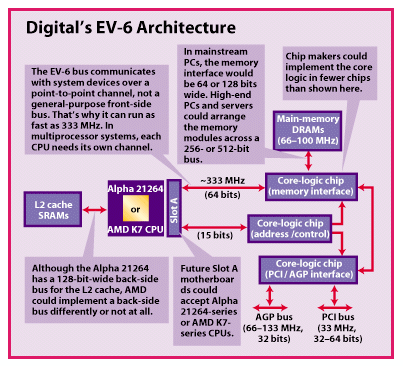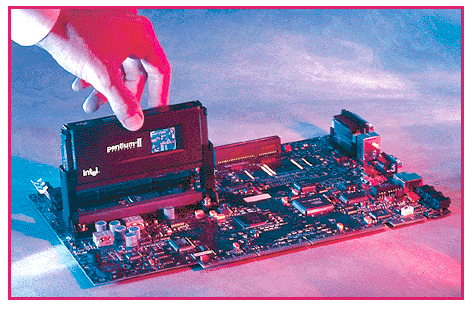| Jerry Sanders, founder and CEO of Advanced Micro
Devices, dropped a bombshell during his keynote speech at
the recent Microprocessor Forum: In 1999, AMD's future K7
processor will come in a cartridge that's physically
compatible with Intel's proprietary Slot 1. But AMD's new
CPU interface, tentatively dubbed Slot A, won't be
electrically compatible with Slot 1. Before the audience of stunned engineers could digest that information, Sanders continued. The K7 will abandon the x86-standard Socket 7 bus in favor of the I/O bus on Digital Equipment's Alpha 21264 processor. And to wrap up the surprise, Sanders added that future 21264 chips will adopt the same cartridge and will work interchangeably with K7 cartridges on Slot A motherboards. Even Digital was caught off-guard. Although Digital and AMD had worked out the deal, Digital didn't know Sanders was going public so soon. Sanders probably wanted to launch a preemptive strike against the growing speculation that AMD wasn't prepared for life after Socket 7. The new alliance with Digital will bring a blazingly fast I/O interface to AMD's processors while opening up a larger market of commodity-priced motherboards to Digital's RISC chips. AMD had to do something, because Intel's P6-series processors (the Pentium Pro and the Pentium II) introduced a proprietary CPU interface that's protected by numerous patents. Cloning it is technically easy, but it's legally difficult. And even if the patents did not exist, AMD is forbidden to clone the P6 interface by a 1996 settlement ending a long-running court battle over Intel's intellectual property. Intel's P6 interface takes several physical forms, all adhering to the same electrical-bus protocol. Pentium Pro chips use Socket 8. Pentium II chips come in a Single Edge Contact (SEC) cartridge that fits Slot 1, Slot 2, or a smaller slot for notebook computers. The SEC cartridge is really an enclosed daughterboard with a heat sink that slides down through a pair of vertical channels into a slot on the motherboard (see the photo). The P6 interface has a 64-bit-wide system bus that runs at 66 MHz, which will soon increase to 100 MHz when Intel releases the 440BX chip set. It also has a separate 64-bit-wide back-side bus for the Level 2 (L2) cache. In Slot 1 systems, the back-side bus typically runs at half the frequency of the CPU core. In Slot 2 systems, it can run as fast as the core (333 MHz and higher with Deschutes). Because Intel isn't licensing the P6 interface to competitors who make x86-compatible processors, nobody else can make chips that work on the same motherboards as Intel's processors. That's a big change from Socket 7, which any vendor can use. However, Intel's patents cover only the P6-bus protocol, not the physical cartridges or connectors. Those parts are available from multiple suppliers. AMD's plan is to leverage the growing infrastructure for the parts by introducing a CPU interface that's physically compatible. It's less costly than inventing a new interface and lobbying suppliers to support it. Also, Slot A motherboards would be very similar to Slot 1 motherboards, requiring only a different core-logic system chip set and some minor layout changes. That would make life easier for motherboard manufacturers. (Actually, Slot A probably won't be exactly the same as Slot 1. To prevent accidental damage to motherboards and CPUs, Slot A will almost certainly be keyed in a slightly different way so users can't insert an Intel cartridge into AMD's slot or vice versa.) AMD needed a next-generation I/O interface to go along with Slot A. The company chose Digital's 21264 interface (which is known internally as EV-6), because it offers significant advantages over Socket 7: much higher clock frequencies and better support for multiprocessing. While Socket 7 currently runs at 66 MHz and will soon step up to 100 MHz, EV-6 can run at a blazing 333 MHz. That's over three times faster than Socket 7 or Intel's P6 bus. And although EV-6 doesn't define a separate back-side bus for an L2 cache, designers are free to add one if they wish — allowing more flexibility for different markets. For instance, Digital's high-end 21264 implements a 128-bit-wide back-side bus, twice as wide as Intel's. How can EV-6 run at 333 MHz when even a 100-MHz motherboard is difficult to engineer? Because EV-6, strictly speaking, isn't a bus. It's a 64-bit, point-to-point I/O channel between the CPU and the system chip set. That's a major departure from today's x86 buses. In a Socket 7 system, the CPU, L2 cache, main memory, and PCI bus all hang off the same local I/O bus. P6 systems are similar, except that the L2 cache is on a back-side bus. In both those systems, the local I/O bus must also handle the Accelerated Graphics Port (AGP), if one is present. In a multiprocessor system, additional CPUs also share the bus. This all adds up to a great deal of bus traffic. In an EV-6 system, the CPU talks directly to the chip set over a private channel. The chip set, in turn, branches off to all the other buses: main memory, PCI, and AGP. Each of those buses runs at its own speed. Main memory could run at 66 or 100 MHz while the PCI bus runs at 33 MHz and AGP runs at 66 MHz. In a multiprocessor system, each CPU has its own private channel (clocked as high as 333 MHz) to the chip set. (See the figure "Digital's EV-6 Architecture".) At 333 MHz, EV-6 has 2.6 GBps of raw bandwidth, more than three times as much as a Socket 7 or P6 bus at 100 MHz. That's an enormous advantage, because the prime factor limiting performance in modern CPUs is the time they take to access memory. A high-end system could exploit EV-6's extra bandwidth by hanging the memory on a 128-bit-wide bus on the chip set. That would double the amount of raw bandwidth to memory. Even if the memory is on a conventional 64-bit bus, EV-6's headroom should mean fewer stalls while the CPU refills its cache lines. The downside: EV-6 chip sets are more complicated to design, and chip sets for multiprocessor systems will be expensive, because they'll need at least 64 additional pins for each CPU. AMD is working with third-party vendors such as VIA to design EV-6 chip sets. For Digital, the big win is that future Alpha processors that have EV-6 and a Slot A cartridge will plug into the same motherboards as AMD's K7 processor. Only the BIOS needs to change. Since modern BIOSes use flash ROM, it's a quick software upgrade. Today, Alpha systems are relatively expensive because they require special motherboards and chip sets that aren't made in large volumes. If AMD is successful, there will be a lively commodity market for Slot A motherboards. Together with lower-priced Alpha CPUs (such as an EV-6 variant of the 21164 PC), this could bring Alpha system prices down to the $1500 range. The Alpha would be a mass-market product, such as the x86. "The Alpha will benefit from the economies of scale of having a large-volume infrastructure," says Aaron Bauch, Digital's technical marketing manager. Some observers wonder if the industry will support two or more different CPU interfaces that require different motherboards and core-logic chips. A few years ago, that would have been a major concern. But the industry has grown so large that companies can profitably support multiple standards. "It's no big deal to design a custom motherboard for different CPUs," says Don Clegg, vice president of marketing for Tyan Computer, a major motherboard manufacturer. "But we'd like to see the motherboard form factors remain industry-standard: AT, ATX, NLX. If the board doesn't fit a standard chassis, it will become more like the notebook market." There are other considerations that might determine how many companies support AMD's slot. Tyan won't say if it plans to build Slot A motherboards but notes that it enjoys good relations with Intel and would like to keep it that way. On the other hand, Intel's encroachment into the motherboard and core-logic business is squeezing some companies out of the market. Therefore, they may have little choice but to support an alternative. AMD's plan could have a greater chance of succeeding if other x86 vendors also adopt EV-6. Digital says it's willing to license the technology to anyone. However, Cyrix told BYTE it will not use EV-6. Instead, Cyrix hints it may clone Intel's P6 interface, despite the scary patents. Cyrix was recently acquired by National Semiconductor, and National has a patent cross-licensing agreement with Intel. Cyrix thinks that agreement might cover the P6 interface. If Intel sees things differently, Cyrix could fight it out in court. "I don't intend to lose," says Steve Tobak, vice president of corporate marketing for Cyrix. "We've never lost in court to Intel before." The third independent vendor of x86 processors, Centaur Technology, isn't talking about its plans beyond Socket 7. It's possible that Centaur could stick with the socket longer than others, because Centaur aims for the low-end market, where Socket 7 is not really a handicap. Can AMD and Digital succeed in establishing a viable alternative to Intel's P6 standard? There's a good chance they could pull it off. AMD captured about 10 percent of the x86 market in 1997. That's down from 30 percent in 1992, when AMD's 386 competed strongly with Intel. But with the market expanding beyond 100 million units a year, even 10 percent could be enough to sustain Slot A. AMD has grander ambitions, though. Jerry Sanders says AMD must recapture about 30 percent market share to pay for the expensive R&D and chip foundries required to compete with Intel in the future. That will be much more difficult to achieve, unless the swing to lower-priced PCs cuts deeply into Intel's high-margin business. Intel's profit margins are soaring above 60 percent — higher than Apple's in the 1980s. If sub-$1000 systems continue to grow in popularity, Intel will have to sacrifice either profit margins or market share. It's a balance of technology and business. Intel may choose to preserve its current business model, keep its shareholders happy, and allow AMD to recapture the market share it enjoyed in the heyday of the 386. Digital's EV-6 Architecture Upgradable or Obsolete? Copyright 1994-1998 BYTE |